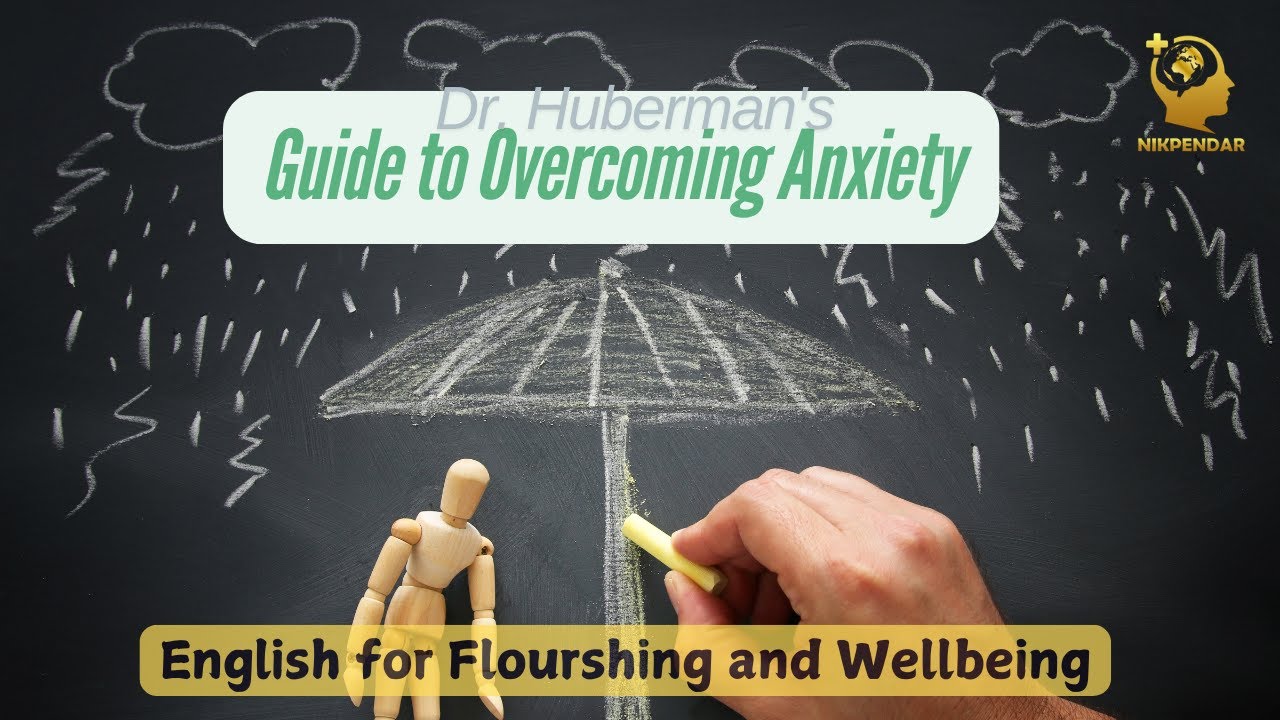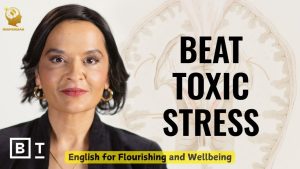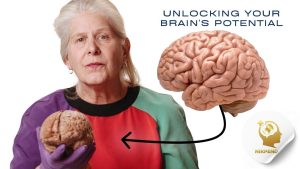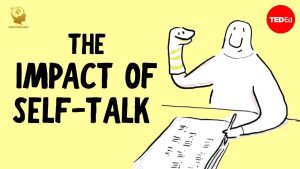
Beginner
Task 1: Moving for Better Feelings
- Instruction: The speaker talks about how moving your body can make you feel better. What kind of movement is good for reducing anxiety? What feeling does it help you have?
- Time: 30-45 seconds
- Prompt: “Based on the video, how can moving your body help you feel less anxious?”
Task 2: Your Amazing Eyes
- Instruction: The speaker says our eyes are special parts of our brain. What important thing do our eyes do when they see sunlight in the morning?
- Time: 30-45 seconds
- Prompt: “According to the speaker, what is one important thing our eyes do, especially with sunlight?”
Intermediate
Task 1: Self-Generated Optic Flow
- Instruction: The speaker mentions “self-generated optic flow.” Explain what this means in your own words, and why it’s important for reducing anxiety. Give examples from the text.
- Time: 1-1.5 minutes
- Prompt: “Can you explain the concept of ‘self-generated optic flow’ and its connection to reducing anxiety, using examples from the transcript?”
Task 2: Understanding EMDR
- Instruction: The transcript describes EMDR (Eye Movement Desensitization Reprocessing). Briefly explain what EMDR is and how it was discovered. Do you think this kind of therapy sounds effective?
- Time: 1.5-2 minutes
- Prompt: “Describe EMDR therapy based on what you heard. What’s your initial thought on its effectiveness?”
Advanced
Task 1: The Eyes as Controllers of Internal State
- Instruction: The speaker makes a strong claim that our eyes are “pieces of your brain outside your skull” designed to “set our internal state of arousal or calm.” Elaborate on this idea, drawing connections between vision, brain function, and internal states as discussed in the transcript (e.g., circadian biology, trauma).
- Time: 2-3 minutes
- Prompt: “Discuss the speaker’s concept of the eyes as fundamental controllers of our internal state. How does this understanding impact our view of mental health and daily practices?”
Task 2: Leveraging Neuroscience for Well-being
- Instruction: The speaker discusses how scientific discoveries about forward movement and eye movements can be “leveraged for mental health and mental disease.” Choose one of these insights (forward movement or eye movements) and discuss how you think this scientific understanding could be practically applied in everyday life or in therapeutic settings to improve well-being.
- Time: 2.5-3.5 minutes
- Prompt: “Considering the scientific insights presented, how can we practically leverage forward movement or eye movements to enhance mental health and well-being?”
Beginner
Task 1: True or False Listen to the beginning of the transcript.
- Forward movement helps reduce fear. (True/False)
- Driving a car helps reduce anxiety in the same way as running. (True/False)
Task 2: Short Answer Listen to the part about eyes and sunlight.
- What happens to our brain and nervous system when we view sunlight in the morning?
- Are our eyes connected to our brain, or are they part of our brain?
Intermediate
Task 1: Explaining Concepts
- The speaker talks about “self-generated optic flow.” What does this mean, and what activities are examples of it? How does it help reduce anxiety?
- Who discovered EMDR, and what did she notice while she was taking a walk that led to its discovery?
Task 2: Identifying Details
- According to the speaker, what kind of traumas does EMDR work best for?
- What two main things are the eyes designed to do, according to the speaker, besides just seeing objects?
Advanced
Task 1: Analysis and Elaboration
- Explain the scientific mechanism by which “forward movement” influences our internal state, referencing the specific brain parts and chemical mentioned (e.g., dopamine, nucleus accumbens, amygdala).
- The speaker states, “the eyes are brain.” Elaborate on this concept. What evidence or reasoning does he provide to support this claim, and what significant role does he say the eyes play in controlling our internal state beyond just sight?
Task 2: Critical Thinking and Implications
- Compare and contrast how self-generated optic flow (bodily movement) and viewing morning sunlight both impact our internal states and contribute to well-being. What are the distinct mechanisms at play for each?
- Based on the discussion, what “tremendous power” of vision is the speaker’s lab actively pursuing? How might this understanding be leveraged for mental health and mental disease treatment?
Beginner
Instructions: Read the transcript carefully and answer the following questions.
- True or False: Forward movement, like running, helps to reduce anxiety.
- ( ) True
- ( ) False
- Circle the correct answer: When you drive a car, does it create “self-generated optic flow” in the same way as running?
- ( ) Yes
- ( ) No
- Fill in the blank: EMDR was a discovery made by Francine __________.
- Complete the sentence: According to the speaker, your eyes are actually two pieces of your _________ outside your skull.
- What happens when you view sunlight in the morning? (Choose one)
- a) It makes you more tired.
- b) It wakes up your brain and nervous system.
- c) It helps you remember dreams.
Intermediate
Instructions: Read the transcript and answer the questions with short answers or brief explanations.
- Explain what “self-generated optic flow” is and why the speaker says driving a car does not create it in the same way running or biking does.
- How did Francine Shapiro discover the technique that later became known as EMDR? Describe the circumstances of her discovery.
- According to the transcript, what is the primary role or “design” of our eyes beyond just seeing objects?
- List two specific ways that forward movement (self-generated optic flow) helps to reduce anxiety, mentioning a brain area and a chemical.
- For what types of trauma does EMDR work best, according to the speaker’s colleagues in psychiatry?
Advanced
Instructions: Read the transcript thoroughly and answer the following questions with detailed explanations and analysis.
- Analyze the neurobiological mechanism by which “forward movement” is stated to reduce anxiety and activate a “courage or confrontational response.” Discuss the roles of dopamine release and the amygdala in this process.
- Evaluate the significance of EMDR being a “board certified” behavioral practice for trauma treatment. What does this certification imply about its scientific validation and acceptance within the psychiatric community, as suggested by the speaker?
- Elaborate on the speaker’s assertion that “the eyes are central nervous system… they are brain.” Discuss how this anatomical perspective underlies their profound influence on our “internal state of arousal or calm” and circadian biology, as described in the transcript.
- Synthesize the speaker’s overall argument about the powerful connection between bodily movement, vision, and internal mental states. How does the speaker suggest that these insights could be “leveraged for mental health and mental disease”? Provide specific examples from the text to support your points.
- Based on the entire transcript, discuss the speaker’s role as a “student and teacher in the field of happiness studies.” How does this specific information about the brain and body contribute to the broader understanding of well-being, particularly in relation to overcoming fear and trauma?
Beginner
Task 1: Move Your Body, Change Your Feelings
The speaker talks about how moving your body can change how you feel. What kind of movement helps reduce anxiety? What good feeling does it activate? Give two examples of this type of movement. Write 3-4 simple sentences.
- Keywords to use: movement, anxiety, reduces, courage, running, biking
Task 2: Your Eyes and Waking Up
The speaker explains how looking at sunlight in the morning affects your body. What does sunlight do to your brain and nervous system in the morning? What does it set a “timer” for later? Write 3-4 sentences.
- Keywords to use: eyes, sunlight, wakes up, brain, melatonin, evening
Beginner
Task 1: Move Your Body, Change Your Feelings
The speaker talks about how moving your body can change how you feel. What kind of movement helps reduce anxiety? What good feeling does it activate? Give two examples of this type of movement. Write 3-4 simple sentences.
- Keywords to use: movement, anxiety, reduces, courage, running, biking
Task 2: Your Eyes and Waking Up
The speaker explains how looking at sunlight in the morning affects your body. What does sunlight do to your brain and nervous system in the morning? What does it set a “timer” for later? Write 3-4 sentences.
- Keywords to use: eyes, sunlight, wakes up, brain, melatonin, evening
Intermediate
Task 1: The Science of Forward Movement
Explain how “forward movement” (also called “self-generated optic flow”) reduces anxiety, according to the transcript. Mention the chemical released and the part of the brain involved in suppressing fear. Why is driving not considered effective for this?
- Word Count: 100-150 words
- Concepts to include: forward movement, self-generated optic flow, anxiety, dopamine, amygdala, fear suppression, bodily movement vs. driving.
Task 2: EMDR and Trauma Treatment
Based on the speaker’s description, what is EMDR (Eye Movement Desensitization Reprocessing)? How was it discovered, and how does it work to help people with traumatic events? What type of traumas does it work best for?
- Word Count: 120-180 words
- Concepts to include: EMDR, Francine Shapiro, eye movements, traumatic events, uncoupling, single event traumas.
Advanced
Task 1: The Brain Outside the Skull: Vision’s Power
The speaker asserts that “the eyes are pieces of your brain outside your skull” and were designed to “set our internal state of arousal or calm.” Discuss the neurological basis for this claim, drawing specific details from the transcript (e.g., retinas, central nervous system, cortisol/melatonin secretion). Analyze the “tremendous power” this understanding holds for mental health, circadian biology, and the treatment of trauma.
- Word Count: 200-250 words
- Key Concepts to address: eyes as brain, retinas, central nervous system, internal state (arousal/calm), circadian biology, cortisol/melatonin, trauma treatment, mental health implications.
Task 2: Leveraging Behavioral Practices for Well-being
The transcript highlights two key behavioral practices: self-generated optic flow and EMDR. Compare and contrast the mechanisms by which these practices impact internal states and reduce distress, as explained by the speaker. Discuss the broader implications of these discoveries for everyday well-being and clinical applications. Consider how a greater understanding of these connections between movement, vision, and brain states could be leveraged to promote mental health and prevent mental disease.
- Word Count: 250-300 words
- Key Concepts to address: self-generated optic flow, EMDR, mechanisms (dopamine, amygdala, eye movements), anxiety reduction, trauma treatment, behavioral practices, leverage for mental health, prevention.





